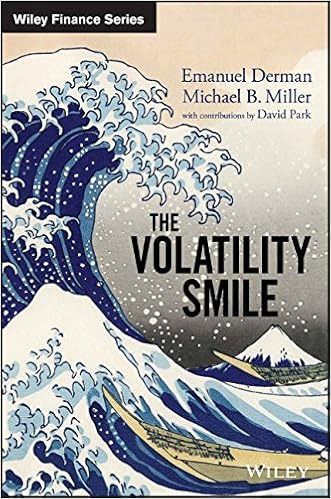I always do this.
I'm casually scanning the Amazon Vine list, scrolling past beauty aids and iPhone covers when I come across "The Volatility Smile".
What kind of title is that? A detective story with a Japanese print on its front cover?
OK, it's got my attention. And then it gets worse:
"The Black–Scholes–Merton option model was the greatest innovation of 20th century finance, and remains the most widely applied theory in all of finance. Despite this success, the model is fundamentally at odds with the observed behavior of option markets: a graph of implied volatilities against strike will typically display a curve or skew, which practitioners refer to as the smile, and which the model cannot explain. Option valuation is not a solved problem, and the past forty years have witnessed an abundance of new models that try to reconcile theory with markets.
"The Volatility Smile presents a unified treatment of the Black–Scholes–Merton model and the more advanced models that have replaced it. It is also a book about the principles of financial valuation and how to apply them. Celebrated author and quant Emanuel Derman and Michael B. Miller explain not just the mathematics but the ideas behind the models."
I have only the haziest memory of understanding puts and calls once, but this sounds fascinating! A free book to review with some serious analysis.
As is the way with Amazon Vine, it arrives the very next day and I begin to appreciate the enormity of what I've done.
- Authors: theoretical physicist, mathematical economist, physicist
- The text, though billed as 'for traders', name-drops Hilbert spaces in the prologue
- We hit Black-Scholes really hard!
What really works though is the continuous version, the Wiener process which seems to underlie the Black-Scholes model. This, in its turn, seems to require something I hadn't heard of before, the Itô calculus.
Did I mention Martingales?
My problem is that I lack all orientation in this forest of technical virtuosity. Still, I even know where to go in these situations: YouTube.
Searching for a "conceptual overview of Black-Scholes" gets you a stack of introductory lectures. The Khan Academy (ten minute clip) was really simple and sketched the big picture: I'm to think of it as pricing call options.
I don't think those shouty traders know much about partial differential equations or their extension to stochastic processes. This book is quant territory - I'm not surprised that most senior money managers were all at sea back in 2008.
Still, I have the map of the territory now (I re-read the very clear Wikipedia article on call options) so it's time to get back to the book.
I'm looking forward to writing a semi-informed review .. at some point.
---
Update (Saturday Feb 4th 17): I've now posted the review.

I have read a few books in this area, including a previous one by (ex-mathematical physicist) Derman who wanted to be sure when Interviewing that applicants really did understand Maxwell's Equations.
ReplyDeleteIf you become interested in this area then you will find that Black-Scholes has been blamed for aspects of the 2008 Credit Crunch. In particular its use of the Gaussian distribution with the Random Walk. Mandelbrot never did agree to that and believed that a more general type of Stochastic Equation should be used IE the Stochastic equations (in Black-Scholes etc) are *too* simple (!) to model the "real world".